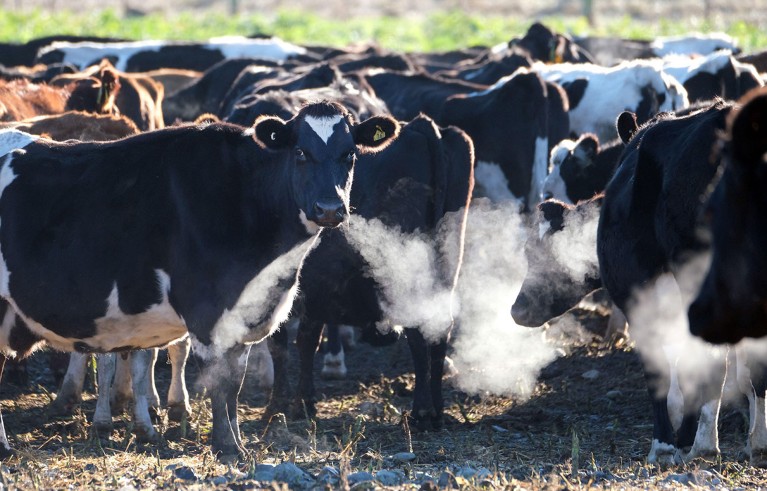Can H5N1 spread through cow sneezes? Experiment offers clues


H5N1 was first identified in cattle in Texas in March and has spread to herds in more than a dozen states.Credit: Simon Runting/Alamy
Cows can get infected with the highly pathogenic avian influenza H5N1 by breathing in virus-laden aerosols, according to a preprint1 posted on bioRxiv. But scientists say this mode of transmission is probably not driving the current outbreak among cattle in the United States.
H5N1 was first identified in cattle in Texas in March 2024. Since then, the virus has been detected in 157 herds and 4 people in contact with cattle across 13 US states. Studies have suggested that the main transmission route in cows is through infected milk, which is contaminating milking equipment.
Before the outbreak, researchers didn’t know that influenza A viruses, such as H5N1, could spread in cows. Scientists have raised concerns that should H5N1 spread effectively in cows through the respiratory system, it would be harder to control and the risk of it spreading to humans would increase, given the close contact that cows have with people.
To better understand infections in cows, several teams conducted challenge studies in which they experimentally infected animals with H5N1. The first results from one of these studies were posted on 13 July and have not been peer reviewed.
Virus-laden mist
Amy Baker and her colleagues at the US Department of Agriculture (USDA) in Ames, Iowa, infected cows and calves with the specific H5N1 strain isolated in Texas cattle early in the outbreak. They exposed four female one-year-old calves to virus-laden mist through a mask that covered the animals’ noses and mouths. All of the infected animals produced neutralizing antibodies against the virus, confirming that they were infected.
The infected calves exhibited mild symptoms, and the researchers isolated infectious virus in the upper airways of two of the four calves. The study findings suggest that in an environment where hundreds of animals are held in close quarters, the virus could be spreading through the respiratory route.
But given that the animals did not shed virus at high levels in their airways, it is probably not a major source of spread, says Thomas Peacock, a virologist at Imperial College London. It’s possible, however, that cows could be getting indirectly infected through the respiratory route through aerosolized virus shed from the udder, he adds.
Wendy Barclay, a virologist at Imperial College London, agrees that because low levels of infectious virus were detected in the animals despite their exposure to high doses of H5N1, airborne transmission is probably not efficient, nor can it “explain what is going on at present”.
Instead, the study adds to previous work that suggests the virus is mainly spreading through infected milk, say researchers. “Udder-to-udder transmission still seems most likely to be the major route at present,” says Peacock. “That doesn’t mean the virus can’t change though, if this outbreak continues at the pace it currently is,” he says. “What we must now do is to keep a careful watch on the virus.”
The study mainly looked at the susceptibility to infection of cows, not transmission, which makes it difficult to draw conclusions about viral spread, says Jürgen Richt, a veterinary virologist at Kansas State University in Manhattan. Richt has done his own cow experiments together with colleagues in Germany, and the results should appear in a preprint within weeks.
Clotted milk
Baker and her colleagues also inserted virus through teats in the mammary glands of two lactating three-year-old cows. Two days after being infected, the cows showed signs of inflammation of the mammary glands, which lasted for two weeks. They began to produce less milk, and the milk also turned yellow and thick.
The researchers detected infectious virus in the mammary glands for the three weeks of the study, and for up to two weeks in the milk. These findings “point to the mammary gland and milk as primary sources of virus spread within and between dairy herds”, according to the preprint.
Richt says the study reflects what has been observed in farms. But given the small number of animals included in the studies, respiratory transmission cannot be ruled out, he says.





